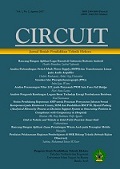Cytotoxic Activity of Aporphine Alkaloids from Alseodaphne Peduncularis (Wall. Ex. Ness) Meissn against Hela Cell Line
DOI:
https://doi.org/10.22373/crc.v1i2.769Keywords:
Lauraceae, Alseodaphne peduncularis, Aporphinoid, CytotoxicAbstract
Genus of Alseodaphne has been known as a source of apoprhine alkaloid that displayed potent cytotoxic activities against selected cell lines. Two aporphine alkaloids, Corydine 1 and norlirioferine 2 were isolated from leaves of Alseodaphne peduncularis (Wall. Ex. Ness) Meissn. (Lauraceae). Phytochemical study involved extraction, separation and purification by using various chromatography methods and structural elucidation by using spectoscopic techniques such as UV, IR LC-MS and 1D and 2D NMR. These compounds were then assayed for cytotoxicity against human uteric cervical tumor (heLa) and compare for safety with normal mouse fibroblast (NIH/3T3) cell lines by using the MTT assay. Compound 2 displayed potent cytotoxic activities against heLa cell, but compound 1 showed as inactive. Both compounds have no significant effect against NIH/3T3 cell lines indicated good for cancer agent treatment.Downloads
Published
2016-01-02
Issue
Section
Articles
License
Authors who publish in CIRCUIT: Jurnal Ilmiah Pendidikan Teknik Elektro agree to the following terms:
- Authors retain copyright and grant the journal right of first publication with the work licensed under a Creative Commons Attribution-ShareAlike 4.0 International License (CC BY-SA 4.0) that allows others to share and adapt the work with an acknowledgement of the authorship and initial publication in this journal
- Authors are able to enter into separate, additional contractual arrangements for the non-exclusive distribution of the journal's published version of the work (e.g., post it to an institutional repository or publish it in a book), with an acknowledgment of its initial publication in this journal.
- Authors are permitted and encouraged to post their work online (e.g., in institutional repositories or on their website) prior to and during the submission process, as it can lead to productive exchanges, as well as earlier and greater citation of published work. (See The Effect of Open Acces)

